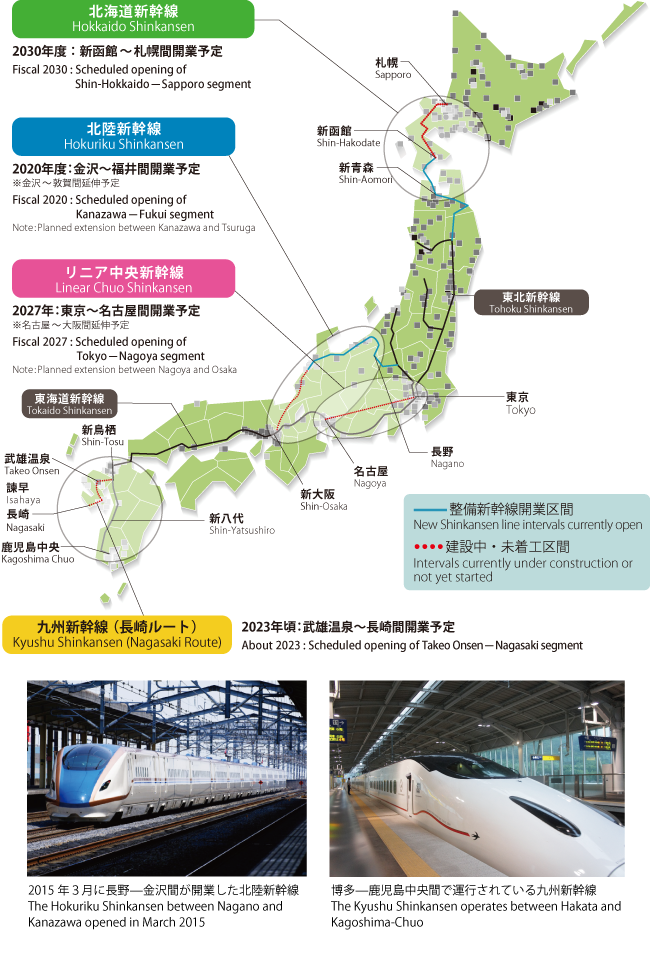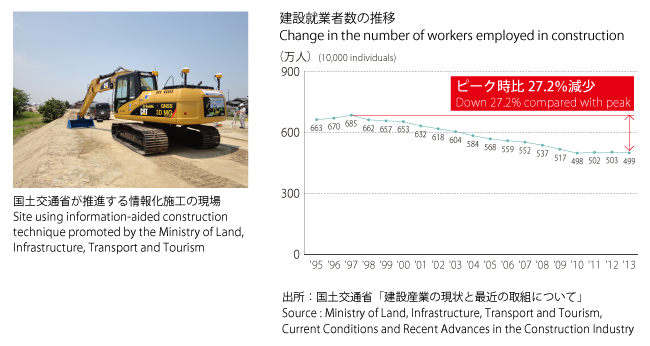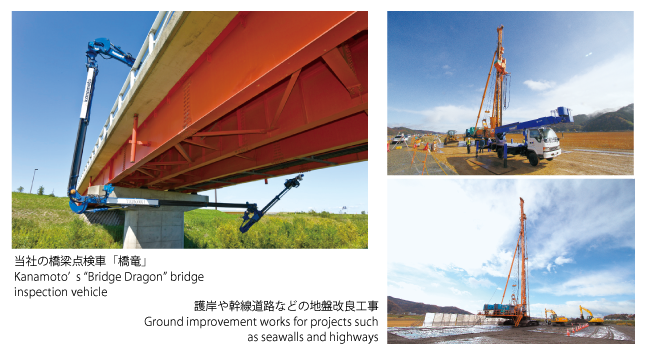Warning: include(/home/c9205967/public_html/kanamoto.ne.jp/include/menu_51annual_en.php): Failed to open stream: No such file or directory in /home/c9205967/public_html/kanamoto.ne.jp/en/pub/51/annualreport/06/index2.html on line 116
Warning: include(): Failed opening '/home/c9205967/public_html/kanamoto.ne.jp/include/menu_51annual_en.php' for inclusion (include_path='.:/opt/alt/php82/usr/share/pear:/opt/alt/php82/usr/share/php:/usr/share/pear:/usr/share/php') in /home/c9205967/public_html/kanamoto.ne.jp/en/pub/51/annualreport/06/index2.html on line 116
Feature| 1 Domestic
Construction demand in the Tokyo metropolitan area energized by large-scale projects ahead of the 2020 Tokyo Olympics
With the construction of sports venues for the 2020 Tokyo Olympics moving ahead, upgrade of the peripheral transportation infrastructure that will serve these large-scale athletic events has heated up as well. The area that has attracted the greatest attention is the zone around Shinagawa, where dramatic change is anticipated. Redevelopment works based on the National Strategic Special Zones mechanism will begin in earnest from 2016.
In addition to a plan to establish a new line linking central Tokyo and the Tokyo International Airport (Haneda), a new station plan, aimed at beginning operations between the Shinagawa and Tamachi stations on the Yamanote Line and Keihin Tohoku Line in time for the opening of the Olympics, is in the works as well, with about 13 hectares planned for the redevelopment site use. Moreover, because Shinagawa will be the arrival and departure station for the Linear Chuo Shinkansen, which is scheduled to open in 2027, urban development integrated with the new station is anticipated.
Construction plans for transport routes linking land and sea
The Tokyo Olympics will seek to be “compact games”. The key to raising travel efficiency for athletes and spectators during the period when the games are held will be the three ring roads girdling central Tokyo. Construction of the outer ring road (Tokyo Gaikan Expressway) slated for completion in about 2020, and the Ken-o Expressway (Metropolitan Inter-City Expressway) that will encourage traffic flow between each expressway, is being accelerated. A port plan intended to improve the transportation efficiency of not only inland routes but of coastal routes as well is moving ahead. At Tokyo Port, the construction of a container facility is progressing with an eye toward expanding business with Asia. The container handling functions concentrated at the three wharves in Oi, Omi, and Shinagawa will be dispersed, and a new terminal will be constructed in the area outside the central breakwater to improve efficiency. Completion is scheduled for 2020. In addition, a new container terminal, the fifth for the port, will be constructed at Shinkiba in Koto Ward by the mid-2020s.
Shinkansen network reaches all of Japan. Construction of railways that serve as Japan’s “transport axis” heats up
The big topic in Japan’s transportation industry in 2016 is the opening of the Shin-Aomori – Shin-Hakodate Hokuto section of the Hokkaido Shinkansen Line. Thirteen round-trip trains are operating daily, including ten round-trip trains that directly link Tokyo and Shin-Hakodate Hokuto, with the fastest time of 4 hours and 2 minutes. Construction work on the span between Shin-Hakodate Hokuto and Sapporo has commenced as well, with the goal of opening for regular operations in fiscal 2030. For
the Hokuriku Shinkansen, which opened between Nagano and Kanazawa in March 2015, construction has begun between Kanazawa and Tsuruga, with operations planned to commence in fiscal 2022.
Finally, with JR Kyushu also working to open the western Kyushu route (Nagasaki route) on the Kyushu Shinkansen in fiscal 2022, 2016 is set to be a year of significant activity. Because rail widths differ depending on the interval, the Kyushu Shinkansen currently is planning to introduce free-gauge trains capable of traveling over both track gauges.
Linear Chuo Shinkansen construction finally underway
As the new Shinkansen route network expands, the “Linear Chuo Shinkansen”, the largest project since the Tokaido Shinkansen, is finally underway as well. Full-scale works on the Shinagawa Station and the Southern Alps Tunnel in Yamanashi Prefecture have already commenced, aimed at opening the interval between Nagoya and Shinagawa in 2027. The goal is to complete the 285.6km route at a total construction cost of 5,523.5 billion yen.
While the initial plan was to further extend the route to Osaka in 2045, given moves to pull this work forward and pursue the simultaneous start of operations in 2027, excitement surrounding the linear construction project is rising.
Shinkansen lines and the Linear Chuo Shinkansen route in Japan’s various prefectures

Source: Prepared based on materials from the Ministry of Land, Infrastructure, Transport and Tourism
The Kanamoto Advantage ------- Technologies❶
Information-aided construction helping overcome labor shortages as well
Japan’s construction industry currently is facing a serious labor shortage, including a decline in the number of young employees and decrease in the number of skilled operators, as a result of the declining birthrate and growing proportion of elderly individuals. One answer to this issue, which originates in Japan’s social structure, is “information-aided construction”. Information-aided construction is a construction method that utilizes ICT (Information and Communication Technology). Information on the working machine’s position is referenced and compared with design data, and actions such as operational support for the machine operator and automatic controls are implemented during the construction process. Because significant mechanization and productivity enhancements can be achieved as a result, this helps overcome human resource shortages and provides a cost reduction effect.
Kanamoto, which defines “providing new value” as true service, has positioned its Information-aided Construction Promotion Section as a special section to strengthen marketing of information-aided construction across all of the Kanamoto Group’s companies. Kanamoto is providing the latest information-aided construction-related devices and construction equipment and knowhow, and giving its full support to the introduction of information-aided construction.
Construction of infrastructure for national resilience moves forward, including large-scale renovation of expressways and bridges
Since the Great East Japan Earthquake, Japan’s citizens have lived with a heightened awareness of disaster prevention and disaster mitigation. Given their concerns focused on the deterioration of expressways in particular following an incident in which ceiling plates inside a tunnel suddenly collapsed onto the roadway, Japan’s various expressway companies are pressing ahead with renewal programs. As shown on the right-hand page, these programs will focus on implementing renovations and repairs of bridges in particular, with each project significant in scope.
As with its expressways, many of Japan’s 700,000 bridges are antiquated. The percentage of bridges constructed more than 50 years ago had reached 18% as of 2013, a figure that will climb to 43% in 2023 and 67% by 2033. The various infrastructures built during the burst of concentrated construction from the 1960s to the 1980s, including tunnels, dams, railways, ports, and airports, in addition to bridges, will have to be renovated over the decades from the 2010s through the 2030s, but for many of these facilities, the extent of maintenance has remained at a low level.
Given such conditions, the government has approved the expenditure of an astounding 200 trillion yen for “national resilience”. The Basic Plan for Extending the Lifespan of Infrastructure that incorporates the aim of zero critical infrastructure accidents attributable to superannuation is part of this effort as well, and public-works programs concerning infrastructure maintenance and repairs are already being implemented in various regions.
Tokyo Metropolitan Expressway Renovation and Maintenance Plan
| Classification | Route | Length | Cost (100 mil. yen) |
| Large-scale renovation | Route No. 1 Haneda Line | 2.0km | 1,156 |
| Route No. 3 Shibuya Line | 1.5km | 648 | |
| Inner Circular Route | 4.1km | 1,971 | |
| Subtotal | 8km | 3,775 | |
| Large-scale repair | No. 3 Shibuya Line, No. 4 Shinjuku Line, other | 55km | 2,487 |
| Total | 63km | 6,262 | |
East, Central, and West Nippon Expressway (3 NEXCO companies) Renovation and Repair Plan
| Classification | Route | Length | Cost (100 mil. yen) |
| Large-scale renovation | Bridge floor slabs | 224km | 16,429 |
| Bridge girders | 13km | 1,039 | |
| Subtotal | 237km | 17,468 | |
| Large-scale repair | Bridge floor slabs | 359km | 1,601 |
| Bridge girders | 151km | 2,628 | |
| Earth structure fill and cut | 26,556 locations | 4,775 | |
| Tunnel structure and lining works | 131km | 3,593 | |
| Subtotal | 641km | 12,597 | |
| Total | 878km | 30,064 | |
Hanshin Expressway Renovation and Repair Plan
| Classification | Route | Length | Cost (100 mil. yen) |
| Large-scale renovation | Bridge reconstruction | 0.5km | 487 |
| Bridge foundation replacement | 9 sets | 191 | |
| Bridge girder and floor slab replacement | 0.9km | 344 | |
| Bridge floor slab replacement | 3.1km | 488 | |
| 小 計 Subtotal | 5km | 1,509 | |
| Large-scale repair | No. 4 Wangan Line, No. 11 Ikeda Line, other | 57km | 2,176 |
| Total | 62km | 3,685 | |
Source : Prepared based on materials related to the renovation and repair plans announced by each expressway company
The Kanamoto Advantage ------- Technologies❷
Actively promoting new product development and strengthening areas of specialized expertise
As described earlier, bridges throughout Japan continue to age, and the “Bridge Dragon”, a state-of-the-art, high-performance remote-controlled bridge inspection vehicle based on Kanamoto’s original design, is helping to address this problem. Developing new products that utilize the latest technologies, and introducing many construction equipment models based on our original designs, as well as models that are registered in NETIS* (New Technology Information System), can be said to be one of Kanamoto’s strengths.
Our capabilities in handling systems and work methods for the foundation and ground improvement sector are another Kanamoto advantage. We boast an ample lineup of special construction equipment for ground improvement, plus teams of ground improvement specialists at companies within the Group, enabling us to lend a hand for works at locations such as petroleum industrial complexes where deep underground construction work, underwater work and thorough prevention of ground sinking and subsidence are absolutely essential.
As described on pages 22-23, there is vigorous demand for such specialized engineering works equipment in ASEAN nations as well. Kanamoto’s construction equipment is on the job not only in Japan, but at overseas infrastructure construction project sites as well.
*Technical information database accumulated based on the Ministry of Land, Infrastructure, Transport and Tourism’s System for Application of Technology in Public Works Etc. 